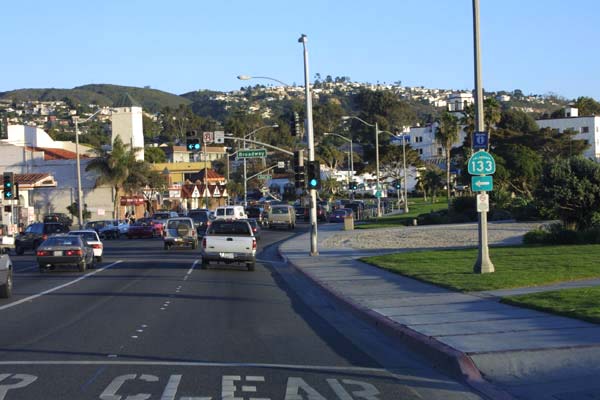 Here's an English residential street (above) done in the brutalist style. The houses are probably cozy enough inside but outside they present an intimidating row of clunky slabs which seem to menace passers-by.
Here's an English residential street (above) done in the brutalist style. The houses are probably cozy enough inside but outside they present an intimidating row of clunky slabs which seem to menace passers-by. The houses also seem oddly out-of-sync with the hilly terrain. Hills are usually friendly and inviting. You want to climb them so you can take in the view and the sweep of the sky. Here the hill has been taken over by big, dark cubes which conspire to block the sunlight and the view of the lowlands.
 Here's another English street (above) built on an old continental model. The architecture may be foreign but it works and I can't for the life of me understand why the English are so reluctant to import good visual ideas from their neighbors.
Here's another English street (above) built on an old continental model. The architecture may be foreign but it works and I can't for the life of me understand why the English are so reluctant to import good visual ideas from their neighbors. Here's the brutalist style again (above), this time in America. This building is a terrain hog which probably throws all the smaller buildings around it out of scale. The building almost certainly is OK inside. Outside it's a big, sentimental, selfish Baby Huey of a slab, solicitous of its own workers and indifferent to everyone else.
Here's the brutalist style again (above), this time in America. This building is a terrain hog which probably throws all the smaller buildings around it out of scale. The building almost certainly is OK inside. Outside it's a big, sentimental, selfish Baby Huey of a slab, solicitous of its own workers and indifferent to everyone else. I thought I'd end on a positive note. Here's a typical cluster of chain stores and gas stations that you find in American hollows where major routes intersect. I want to dislike it but I can't. It's a whore but it's an honest whore. It's happily commercial. Here the weary traveler can find coffee and a bacon, lettuce and tomato sandwich served by a cheerful local waitress. Here are liquor stores full of lottery tickets, tobacco, dirty magazines, candy, comics, beer and ice. Liquor stores are islands of sanity and if they ever disappear the world will be a sadder place.
I thought I'd end on a positive note. Here's a typical cluster of chain stores and gas stations that you find in American hollows where major routes intersect. I want to dislike it but I can't. It's a whore but it's an honest whore. It's happily commercial. Here the weary traveler can find coffee and a bacon, lettuce and tomato sandwich served by a cheerful local waitress. Here are liquor stores full of lottery tickets, tobacco, dirty magazines, candy, comics, beer and ice. Liquor stores are islands of sanity and if they ever disappear the world will be a sadder place.BTW, notice the lack of garish signs and billboards. I've seen places that were actually enhanced by their signs but this little hollow does very well without them.

7 comments:
Interesting post Eddie.
I'd like to point at the fact that those architectural models all have a specific mode of transportation linked to.
English row of terraces are linked to the railway. It all started when it became possible to build the first suburbs where workers could escape to grow their families in a better environment than the polluted town centre and still reach their jobs in a short time.
Those in your photo are ugly houses built quite recently and I suspect that the reason for their existance is that they are built at the edge of towns, expanding it by a process of accumulation without any planning involved. They're cheap to build and they sell. They also produce appalling neighborhoods where people wants to run away from. There are some areas like those in the north of England that are now being pulled down after all the residents voluntarily left.
The European model is a high density place where people can move on foot.
In the photos that you put up there actually 2 people walking by and it's the only photo with pedestrians.
I was born and bred in a place like that and love it. The drawback is the lack of personal space and privacy.
Now I live in an English Victorian suburban terraced house and like it too, there's space, I can do gardening and there's 2 large parks where I can go jogging just round the corner.
The last model is car-generated and has much in common with the rows of shops near railway stations that you find in English suburbs, only for drivers.
The third one, the brutalist American looks like an hotel. If that was the case it would be linked to air travel and people disconnected with their surroundings.
Max: Your comment about transportation influencing architecture was interesting. I have more to say about the right way to build on hills but I think I'll hold off and do a whole blog about it.
You're crazy.
Post the towel.
Eddie -
At the risk of being called a hippie again ...
Are you familiar with Friedensreich Hundertwasser, and if so, what is your take on his architectural work, specifically his "retooling" of boring, brutalist buildings in Austria?
Although he was definately a hippie, he created art and made some statements that certainly seem in alignment with your viewpoint. For instance, Hundertwasser once stated that "visual pollution is more poisonous than any other pollution because it kills the soul."
Happy New Year, sir!
Andrew: Hundertwasser! Thanks for the idea! I'll do a blog about him!
Kali: The towel??? Er....alright, but I need to get a picture of it!
Eddie, have you read Kunstlers Geography of Nowhere? (there is a followup, I think called Home from Nowhere). Probably someone reading here has heard of them, they have been around fifteen years or so.
Also, those books reference a book called A Pattern Language, which is a considerably more intense point of view. Generally supporting organic growth of architecture and city planning, and shunning what has happened since the automobile took over civilization.
Which is, oddly enough, why I have not seen Pixars Cars yet.
Your posting on leaving the womb of Wellesley reminded me of some of the Pattern Language book, which is dogmatic enough for practicallly anyone to agree or disagree with. Like making all the bedrooms face east, so we wake up, instead of sleep all day. What's with that?
Anonymous: Geography of Nowhere? Sounds interesting. I just ordered it from the library. Thanks!
I bought and read Pattern Language a long time ago and was much impressed but I can't remember much from it. I'll try to find it.
Post a Comment